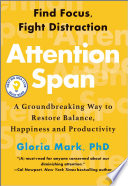

In today's digital age, distractions are ubiquitous, with smartphones, social media, and constant notifications vying for our attention. The book analyzes how these digital distractions impact our ability to focus and be productive. It presents research findings on the detrimental effects of multitasking and constant connectivity on our cognitive performance. The author advocates for setting boundaries with technology, such as designated 'no-screen' times, to foster deeper engagement with tasks and improve overall productivity.
Continue readingThe book begins with a deep dive into the neuroscience of attention, explaining how our brains process information and what factors can enhance or diminish our attention spans. It discusses the role of dopamine in motivation and focus, illustrating how modern stimuli can hijack our brain's reward systems. The author emphasizes the importance of understanding these mechanisms to reclaim our attention in a world filled with distractions. Practical strategies are offered, such as mindfulness practices and cognitive exercises, to train our attention and improve mental clarity.
Continue readingThe concept of 'deep work'—the ability to focus without distraction on cognitively demanding tasks—is a central theme in the book. The author argues that cultivating deep work is essential for achieving high levels of productivity and creativity. Various techniques are discussed, including time-blocking, creating distraction-free work environments, and establishing rituals that signal the brain to enter a state of deep focus. The book provides case studies of successful individuals who prioritize deep work and the benefits they reap from it.
Continue readingThe author introduces Attention Restoration Theory, which posits that our attention can be replenished through exposure to nature and restorative environments. The book highlights the significance of taking breaks and spending time outdoors to revitalize our mental faculties. Practical suggestions include incorporating nature walks into daily routines and designing workspaces that include natural elements. The author emphasizes that these restorative practices can enhance focus and overall well-being.
Continue readingMindfulness practices are presented as effective tools for enhancing attention spans. The book outlines various mindfulness techniques, such as meditation and breathing exercises, that can help individuals cultivate greater awareness and control over their attention. By training the mind to focus on the present moment, readers can learn to resist distractions and improve their ability to concentrate. The author provides step-by-step instructions for incorporating mindfulness into daily life, making it accessible for readers of all backgrounds.
Continue readingThe physical and social environments we inhabit can significantly influence our attention spans. The book discusses how cluttered spaces, noise, and social distractions can detract from our ability to focus. The author advocates for creating an optimal work environment that minimizes distractions and promotes concentration. This includes organizing workspaces, using noise-canceling headphones, and establishing social norms that support focused work. The idea is that by consciously designing our environments, we can enhance our attention and productivity.
Continue readingFinally, the book explores the broader cultural shifts that have contributed to declining attention spans in society. The author examines how the fast-paced nature of modern life, the prevalence of instant gratification, and the rise of short-form content have conditioned us to expect quick rewards and constant stimulation. The book calls for a cultural reevaluation of how we value attention and encourages readers to advocate for practices that foster deeper engagement in both personal and professional contexts.
Continue reading